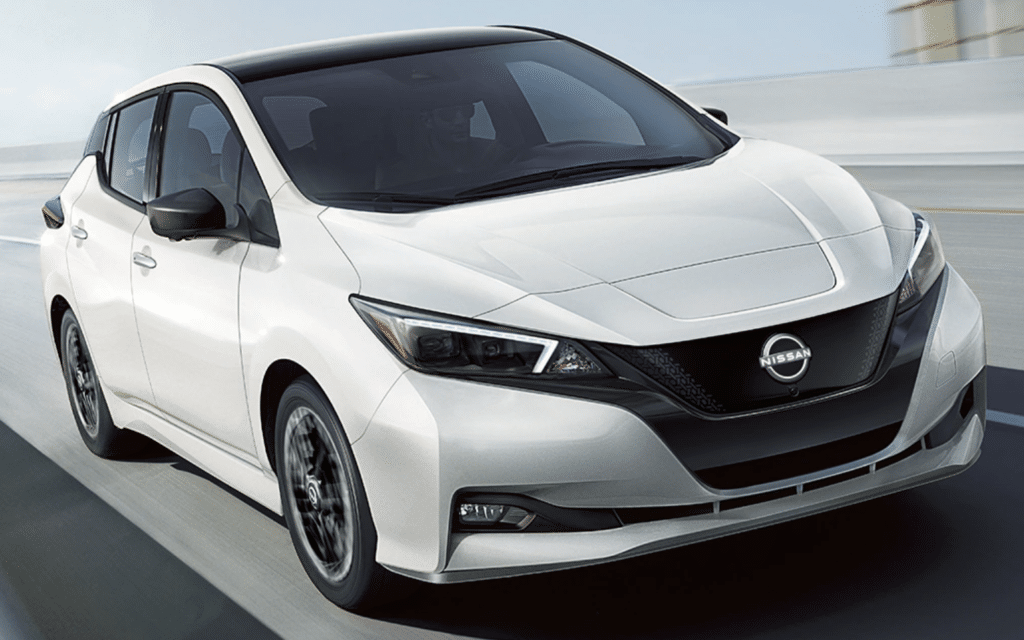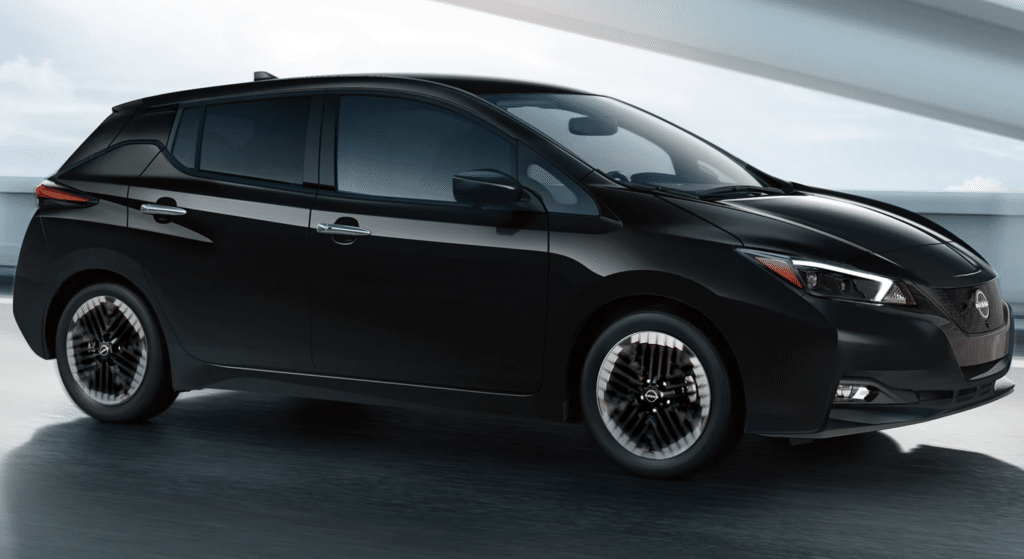Overview – Nissan Leaf e+
The Nissan Leaf was one of the first electric vehicles to hit Australian roads in 2012 and has since gone through several updates for the 2023 model year. It comes in two variants, the entry-level Leaf with a 39kWh battery and a 110kW/320Nm electric motor, and the Leaf e+ with a 59kWh battery and a 160kW/340Nm motor, boasting a range of 385km.

The exterior has been given an understated makeover with updated badging and LED headlights, while the interior has a mix of new-world and old-school features such as a ball-mounted gear selector and a grainy, chunky 8.0-inch multimedia screen.
It’s also a great option for a budget-friendly entry into the world of EVs with a starting price below $30,000 before applicable tax credits, a small, easy-to-maneuver hatchback body, and a comfortable interior outfitted with modern tech features. Its driving range and charging technology, however, are not quite as advanced as some of its competitors, such as the Kia EV6 and Tesla Model 3, which offer longer range and more charging station compatibility.
Nissan Leaf e+ Energy And Carbon Efficiency
The Nissan Leaf e+ has one of the lower carbon emissions figures among the cars compared. It emits 95gCO2/mi, which is lower than the BMW i7 xDrive60 and the Ford Mustang Mach-E SR AWD, and only slightly higher than the Volkswagen ID5 and the Hyundai IONIQ 6.
The Jaguar I-Pace EV400 has the highest carbon emissions figure of the cars compared, at 112 gCO2/mi. Overall, the Nissan Leaf e+ has a relatively low carbon emissions figure compared to other electric vehicles on the market, making it an attractive option for those looking to reduce their carbon footprint.
EV Engine, Power and Performance
The Leaf has a single electric motor delivering 160kW of power and 340Nm of torque. The entry-level Leaf has a 39kWh battery and a 110kW/320Nm motor, while the Leaf e+ has a 59kWh battery and a 160kW/340Nm motor, giving the car a range of 385km according to the WLTP standard. It can be recharged in 21 hours at home or in 1.5 hours with DC fast charging.
It has a power-to-weight ratio of 92kW/t and a turning circle of 11.0m. The Leaf can also be driven in one-pedal mode, using the electric motor as a generator to harvest electrical energy when the accelerator is lifted.
An S model had a 7.4-second zero-to-60-mph time at our test track. The Leaf’s e-Pedal feature allows the driver to toggle back and forth between regenerative braking modes, one of which allows the car to coast when the driver lifts off the throttle and another that slows the car and recharges the battery
Interior Comfort and Cargo Dimensions
The heated leather front seats are relatively comfortable for short and longer distances, with all adjustments being manual. The front doors have bottle holders and two cupholders in the centre console ahead of the small armrest. Access to the back seats is easy through decent-sized doors, and there’s a good amount of legroom and headroom for anyone six foot or less.
The boot offers a competitive 405L of storage and is commendably deep, with a temporary-use spare tyre under the floor. There is no centre armrest for back seat passengers, nor are there any air vents or climate controls. The front-drive Leaf has a transmission tunnel or driveshaft tunnel that a middle seat occupant has to straddle, even though it doesn’t need one.
The interior of the Leaf has a lot of black plastic, with well-assembled, uniform textures. It features a large analog speedometer next to a 7.0-inch digital readout, La-Z-Boy comfortable seats, and a spacious rear seat for adults. Despite the fact that the Leaf’s back seat doesn’t create a flat load floor when folded, the cargo capacity is among the best in its class. We fit seven carry-on suitcases behind the back seat and a whopping 19 with the back seat folded.
Infotainment, Tech and Connectivity
The driver instrument cluster is a combination of old-school speedometer dial and 7.0-inch TFT display for driving range, driving efficiency and other performance monitors. The 8.0-inch multimedia screen has built-in Apple CarPlay and Android Auto, with media playback, satellite navigation, digital radio and screens for driving range and energy usage, using the latest Nissan Connect software interface
There is also an eight-speaker Bose sound system with a subwoofer in the boot, but the sound quality isn’t all that impressive. The Leaf has a 360-degree surround-view camera set-up and an energy regeneration system that slows the car when the accelerator is lifted.
The Nissan Connect software is intuitive and quick to respond to inputs, though the audio system is not particularly impressive.
Safety Features
The Leaf was ANCAP tested in 2018 and earned a five-star rating that will time-out at the end of 2023. It scored 93 per cent for adult occupant protection, 85 per cent for child occupant protection, 71 per cent for vulnerable road user protection and 70 per cent for safety assist.
It has intelligent forward collision warning with emergency braking, lane-departure warning with steering intervention, blind-spot warning and rear cross-traffic alert. It also has six airbags front and back, and two ISOFIX anchor points in the back seat.
The Nissan Leaf has been rated as a Top Safety Pick by the Insurance Institute for Highway Safety. It has a suite of driver assistance and safety features, including automated emergency braking, blind-spot monitoring, lane-keeping assistance, rear cross-traffic alert, and rear parking sensors.

Warranty Information
The Leaf comes with a five-year, unlimited-kilometre warranty that also includes 24-hour roadside assist. Servicing the Leaf happens in 12-month or 20,000km intervals, and will cost $852 for the first three years or $1476 over five years under Nissan’s capped-price servicing plan. The comprehensive insurance quote for the Leaf is surprisingly high for a $60,000 car at $2073.
Final Thoughts
The Leaf drives, rides and steers as effectively as a commuter car should, and it is quiet, has a decent amount of accelerative urge and brakes smoothly. There are close to 50 buttons scattered around the Leaf’s interior, and some of them are in strange positions.
It also has an energy regeneration system and one-pedal mode, and an eight-speaker Bose sound system with a subwoofer in the boot. It comes with a five-year, unlimited-kilometre warranty and servicing costs $852 for the first three years or $1476 over five years. The comprehensive insurance quote is surprisingly high for a $60,000 car at $2073.
The 2023 Nissan Leaf EV is a great option for those who are looking for a budget-friendly entry into the world of EVs. It has a reasonable price and a comfortable interior with modern tech features. However, its driving range and charging technology are not quite as advanced as some of its competitors.
Basic Information
| Make | Nissan |
| Model | Leaf e+ |
| Car Body | Hatchback |
| Number Of Seats | 5 people |
Estimated Energy Efficiency
| Efficiency (mi/kWh) | 4.1 mi/kWh |
| Efficiency (km/kWh) | 6.5 km/kWh |
Engine
| Horsepower | 215 HP (218 PS) |
| Acceleration 0-100 km/h | 6 seconds |
| Towing Weight | 0 lbs (0 kg) |
Charging
| Charge Port | Type 2 |
| Charge Time | 10h45m |
| Fast Charge Power Max | 46 kW DC |
| Fast Charge Time | 59 min |
Safety
| Adult Safety Rating | 93% |
| Child Safety Rating | 86% |
Purchasing
| Available | UK,Netherlands,Germany |
| Date Of Availability | March 2022 |
| Estimated Price | £34,945 / $43,000 |
Estimated Carbon Efficiency (Grid/Country Dependent)
| USA | 95 gCO2/mi (59 gCO2/km) |
| Iceland | 8 gCO2/mi (5 gCO2/km) |
| Canada | 21 gCO2/mi (21 gCO2/km) |
| France | 26 gCO2/mi (16 gCO2/km) |
| Efficient Gas Car | 272 g CO2/mi (170 g CO2/km) |
Battery
| Size (kWh) | 59.0 kWh |
| Voltage (V) | 350 V |
Range
| WLTP Range (km) | 385 |
Dimensions
| Car Length | 177 inches (4490 mm) |
| Car Width | 70 inches (1788 mm) |
| Car Height | 61 inches (1540 mm) |
| Cargo (Trunk or Boot) Volume | 15 cu ft (420 L) |
| Frunk Volume | 0 cu ft (0 L) |
